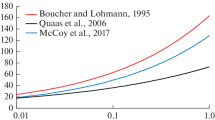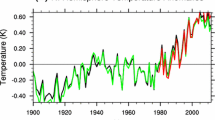Abstract
We considered different properties of stratospheric sulfate aerosols and their size distributions and estimated how efficient they are at compensating for the changes in radiative fluxes at different atmospheric levels and deviation of air temperature during greenhouse warming and upon aerosol dimming. A two-dimensional zonally averaged model of the annually average radiative and thermal regime of the troposphere and stratosphere (the Energy Balance Radiative Convective Model, EBRCM) is used for this. This model allows for assessing the direct effects of changes in many parameters of atmospheric aerosols and the underlying surface, as well as characteristics of aerosol screens. We estimate the sulfate aerosol optical depths and masses for offsetting the annually and zonally averaged increases in the near-ground air temperature, caused by increases in the greenhouse gas content, according to measurements and the IPCC A2 scenario for 1970–2050. No offset is indicated if aerosol screens are emplaced in the polar zones (poleward of 70° N–70° S), and a screen emplaced in just one hemisphere is shown to be incapable of producing total offsetting of global warming.
Similar content being viewed by others
References
A. V. Eliseev, I. I. Mokhov, and A. A. Karpenko, “Global Warming Mitigation by Means of Controlled Aerosol Emissions Into the Stratosphere: Global and Regional Peculiarities of Temperature Response as Estimated in IAP RAS CM Simulations,” Opt. Atmos. Okeana 22, 521–526 (2009) [Atm. Ocean Opt. 22, 388 (2009)].
S. H. Schneider, “Geoengineering: Could or Should We Do It,” Clim. Change 33, 291–302 (1996).
Yu. A. Izrael, “An Efficient Way to Regulate the Global Climate Is the Main Objective of the Solution of the Climate Problem,” Meteorol. Gidrol., No. 10, 5–9 (2005).
Yu. A. Izrael, A. G. Ryaboshapko, and N. N. Petrov, “Comparative Analysis of Geo-Engineering Approaches to Climate Stabilization,” Meteorol. Gidrol., No. 6, 5–24 (2009).
P. J. Crutzen, “Albedo Enhancement by Stratospheric Sulfur Injection: A Contribution to Resolve a Policy,” Clim. Change 77, 211–219 (2006).
S. Tilmes, R. Muller, and R. Salawitch, “The Sensitivity of Polar Ozone Depletion to Proposed Geoengineering Schemes,” Science 320(5880), 1201–1204 (2008).
P. J. Rasch, P. J. Crutzen, and D. B. Coleman, “Exploring the Geoengineering of Climate Using Stratospheric Sulfate Aerosols: The Role of Particle Size,” Geophys. Res. Lett. 35, L02809 (2008).
A. Robock, “Volcanic Eruption and Climate,” Rev. Geophys. 38, 191–219 (2000).
“A Preliminary Cloudless Standard Atmosphere for Radiation Computation,” WCP-112, WMO/TD, No. 24 (1986).
V. Eyring, N. Butchart, D. W. Waugh, H. Akiyoshi, J. Austin, S. Bekki, G. E. Bodeker, B. A. Boville, C. Bruehl, M. P. Chipperfield, E. Cordero, M. Dameris, M. Deushi, V. E. Fioletov, S. M. Frith, R. R. Garcia, A. Gettelman, M. A. Giorgetta, V. Grewe, L. Jourdain, D. E. Kinnison, E. Mancini, E. Manzini, M. Marchand, D. R. Marsh, T. Nagashima, P. A. Newman, J. E. Nielsen, S. Pawson, G. Pitari, D. A. Plummer, E. Rozanov, M. Schraner, T. G. Shepherd, K. Shibata, R. S. Stolarski, H. Struthers, W. Tian, and M. Yoshiki, “Assessment of Temperature, Trace Species, and Ozone in Chemistry-Climate Model Simulation of the Recent Past,” J. Geophys. Res. 111, D22308 (2006).
T. A. Egorova, E. V. Rozanov, V. A. Zubov, E. Manzini, W. Schmutz, and T. Peter, “Chemistry-Climate Model SOCOL: A Validation of the Present Day Climatology,” Atmos. Chem. Phys. 5, 1557–1576 (2005).
I. L. Karol’, “Estimates for the Characteristics of the Relative Contribution of Greenhouse Gases to Global Climate Warming,” Meteorol. Gidrol., No. 11, 5–12 (1996).
I. L. Karol’ and V. A. Frol’kis, “Model Study of Global Mean Zone Thermal Regime of Earth’s Atmosphere,” Meteorol. Gidrol., No. 6, 38–48 (1980).
I. L. Karol’ and V. A. Frol’kis, “Energy-Balance Type Radiative-Convective Model of the Global Climate,” Meteorol. Gidrol., No. 8, 59–68 (1984).
Radiation-Photochemical Models of Atmosphere, Ed. by I. L. Karol’ (Gidrometeoizdat, Leningrad, 1986) [in Russian].
I. L. Karol’ and V. A. Frol’kis, “Estimates of Radiation and Temperature Consequences of Ozone Content Changes in Global Atmosphere During 1980–1990,” Dokl. Akad. Nauk 323, 66–69 (1992).
A. A. Kiselev and V. A. Frol’kis, “The Evolution of Thermal Regime of an Atmosphere Subjected to Predictable Anthropogenic Pollutions,” Izv. RAN, Fiz. Atmos. Okeana 30, 582–587 (1994).
S. Manabe and R. F. Strickler, “Thermal Equilibrium of the Atmosphere with a Convective Adjustment,” J. Atmos. Sci. 21, 361–385 (1964).
W. D. Sellers, “A Global Climatic Model Based on the Energy Balance of the Earth-Atmosphere System,” J. Appl. Meteorol. 8, 392–400 (1969).
M. I. Budyko, Climate Changes (Gidrometeoizdat, Leningrad, 1974) [in Russian].
Climate Change 2001. the Scientific Basis. Contribution of Working Group I to the Third Assessment Report of the Intergovernmental Panel on Climate Change, Ed. by J. T. Houghton, Y. Ding, D. J. Griggs, M. Noguer, P. J. Van Der Linden, X. Dai, K. Maskell, and C. A. Johnson (Cambridge Univ., Cambridge, UK, 2001).
I. L. Karol, V. A. Frolkis, and A. A. Kiselev, “Global Warming Potential, Global Warming Commitment and Other Indexes as Characteristics of the Effects of Greenhouse Gases on Earth’s Climate,” Ecological Indicat., No. 2, 109–121 (2002).
K. P. Shine, J. S. Fuglestvedt, K. Hailemariam, and N. Stuber, “Alternatives to the Global Warming Potential for Comparing Climate Impacts of Emission of Greenhouse Gases,” Clim. Change 68, 281–302 (2005).
Climate Change—the Science of Climate Change, 1995, Ed. by J. T. Houghton, L. G. Meira Filho, B. A. Callander, A. Hattenberg, and K. Maskell (Cambridge Univ., New York, 1996).
J. Hansen, Mki. Sato, R. Ruedy, P. Kharecha, A. Lacis, R. L. Miller, L. Nazarenko, K. Lo, G. A. Schmidt, G. Russell, I. Aleinov, S. Bauer, E. Baum, B. Cairns, V. Canuto, M. Chandler, Y. Cheng, A. Cohen, A. Del Genio, G. Faluvegi, E. Fleming, A. Friend, T. Hall, C. Jackman, J. Jonas, M. Kelley, N. Y. Kiang, D. Koch, G. Labow, J. Lerner, S. Menon, T. Novakov, V. Oinas, Ja. Perlwitz, Ju. Perlwitz, D. Rind, A. Romanou, R. Schmunk, D. Shindell, P. Stone, S. Sun, D. Streets, N. Tausnev, D. Thresher, N. Unger, M. Yao, and S. Zhang, “Climate Simulation for 1880–2003 with GISS Model E,” Clim. Dyn. 29, 661–696 (2007).
D. Deirmendjian, Electromagnetic Scattering on Atmospheric Polydispersions (Elsevier, New York, 1969; Mir, Moscow, 1971).
G. L. Stenchikov, I. Kirchner, A. Robock, H.-F. Graf, J. C. Antuna, R. G. Gringer, A. Lambert, and L. Thomason, “Radiative Forcing from the 1991 Mount Pinatubo Volcanic Eruption,” J. Geophys. Res. D 103, 13837–13857 (1998).
M. Ya. Marov, V. P. Shari, and L. D. Lomakina, “Optic Characteristics of Model Aerosols of Earth’s Atmosphere,” Preprint, Inst. Prikl. Matem. Keldysha AN SSSR, (Moscow, 1989).
E. P. Gordov, O. B. Rodimova, and A. Z. Fazliev, Atmospheric-Optical Processes: Simple Nonlinear Models (Izd-Vo IOA SO RAN, Tomsk, 2002) [in Russian].
Author information
Authors and Affiliations
Additional information
Original Russian Text © V.A. Frol’kis, I.L. Karol’, 2011, published in Optica Atmosfery i Okeana.
Rights and permissions
About this article
Cite this article
Frol’kis, V.A., Karol’, I.L. Simulation of the effect of stratospheric aerosol dimming parameters on the efficiency of offsetting global greenhouse climate warming. Atmos Ocean Opt 24, 74–87 (2011). https://doi.org/10.1134/S1024856011010064
Received:
Published:
Issue Date:
DOI: https://doi.org/10.1134/S1024856011010064




